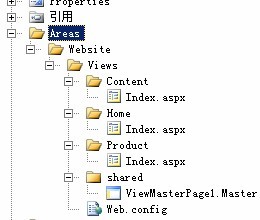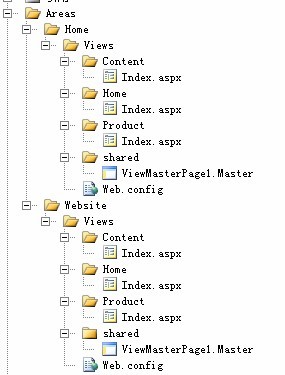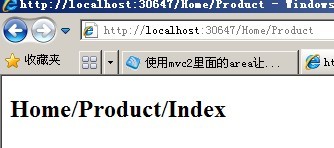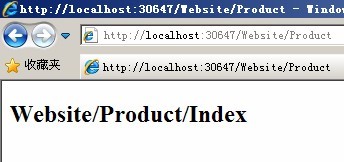51CTO在1月曾专访过微软MVP衣明志老师,主要话题就是ASP.NET MVC 2。其中我们曾谈到Area特性,在这里特组织这篇文章供大家了解ASP.NET MVC 2中的Area。想学习更多ASP.NET MVC,请参考教程《ASP.NET MVC框架视频教程》
最近装了mvc2 pr2版本,看了下说明文档,里面着重提示说更新了area项目,因此着重看了一下。若干心的,和大家共享,有错没错,欢迎大家拍砖。
没有Areas前相同问题的处理
在mvc1.0时代,如果要将网站按目录结构来区分。例如
- Website/Index
- Admin/ Index
- User/ Index
- ……/……
通常都是在Views下面建立若干个和Controller相对应的目录,然后在里面放置aspx页面
- Views\Website\Index
- Views\Admin\Index
- Views\User\Index
- Views\.......\.......
这样建立若干个目录
其实这样也没什么不好,***不好的可能就是随着业务的需要,结构需求会越来越多,views目录下面的文件夹越来越多,更或者你需要更细结构的页面路径,例如:
- Website/Product/Index
- Website/Catalog/Index
- Website/Contect/Index
当然,你可以用UrlRouteing或者ViewEngine搞定这些问题。但是毫无疑问,随着网站的运行日久,同一个Controller目录下的文件会越来越多,对于同一个Controller下的ActionResult的命名和UrlRouting里面的维护带来不小的麻烦。给管理带来不方便【个人理解】。
现在出Areas之后,这个问题有所缓解。还是如上的Url
- Website\Product\Index
- Website\Catalog\Index
- Website\Order\Index
- Website\Contact\Index
可以使用mvc2.0新增的Area来解决这个问题
建立项目
首先,用mvc2建立一个新项目,在网站根目录下建立Areas文件夹,在Areas文件夹建立你要区分的目录,例如本例的Website,然后继续在Website目录下增加Views目录,继续在views目录下增加需要分类管理Controller目录和建立aspx文件。使文件结构形成
- Areas\Website\Views\Product
- Areas\Website\Views\ Catalog
- Areas\Website\Views\ Order
- Areas\Website\Views\ Contact

到原有默认的views目录将web.config复制到现在的新的views目录,你甚至现在可以把原有的views目录删除掉
建立Areas区域UrlRouting
随便找个地方,建立一个新的类,继承AreaRegistration实现抽象类
修改Global.sas
- protected void Application_Start()
- {
- AreaRegistration.RegisterAllAreas();
- //注册区域Url规则,注意先后顺序
- RegisterRoutes(RouteTable.Routes);
- }
为区域页面建立Controller类没什么区别,可以建立在另外一个外部类库项目上,***需要注意的就是命名空间需要和注册Area规则的类的命名空间的前导一致。我们知道,在不使用Areas的时候Controller是不受namespace约束的。也就是说只要你有一个Controller名,而不管他在哪个命名空间下都是可以起作用的,如果我们在不同的命名空间建立2个相同的Controller类名,编译的时候不会出错,但是运行mvc网站的时候会提示存在2个相同的Controller类,系统不知道使用哪个。但是Areas却有所限制,他一定要命名空间的前导和AreaRegistration类得命名空间相同。例如:我建立的AreaRegistration网站项目命名空间为Valor.Asmyna.Areas.Website然后我将Controller分开作为一个独立的类库,如果我随便写一个命名空间空间,这个Controller对于Area里面的views是不起作用的,但是他却对原始Views目录的Controller起作用,只有将他的命名空间设置成Valor.Asmyna.Areas.Website.xxx.xxx的前导才起作用
- namespace Valor.Asmyna.Areas.Website
- {
- public class HomeController : Controller
- {
- public ActionResult Index()
- {
- ViewData["title"] = "Website/Home/Index";
- return View();
- }
- }
- public class ProductController : Controller
- {
- public ActionResult Index()
- {
- ViewData["title"] = "Website/Product/Index";
- return View(); }
- }
- public class ContentController : Controller
- {
- public ActionResult Index()
- {
- ViewData["title"] = "Website/Content/Index";
- return View();
- } }
- }
Ok,到浏览器测试一下看看
Area结构完全一致会出现的问题
我们继续在Area目录下增加一个Home目录,在他的Veiws目录下也增加三个相同的controller目录

直接在刚才注册Website AreaRegistration命名空间为他注册一个Area规则,用默认系默认的Controller为Home.,
对2个路径进行访问:
/Website/Product
/Home/Product
这个时候controller对于这2个area目录的views都能起作用。在页面打印得到的结果一致

显然这样是不对的.由此我们刚才想到Area的Controller的选择名命名空间限制问题。那我们他们分开来注册看看。修改Home区域的AreaRegistration的命名空间和在为HomeArea建立一个Controller类,使他们的命名空间一致。这次我们用Valor.Asmyna.Areas.Website
- namespace Valor.Asmyna.Areas.Home{
- public class HomeController : Controller
- {
- public ActionResult Index()
- {
- ViewData["title"] = "Home/Content/Index";
- return View();
- } }
- public class ProductController : Controller
- {
- public ActionResult Index()
- {
- ViewData["title"] = "Home/Content/Index";
- return View();
- }}
- public class ContentController : Controller
- {
- public ActionResult Index()
- {
- ViewData["title"] = "Home/Content/Index";
- return View();
- }
- }}
- namespace Valor.Asmyna.Areas.Home
- {
- public class HomeController : Controller
- {
- public ActionResult Index()
- {
- ViewData["title"] = "Home/Home/Index";
- return View();
- } }
- public class ProductController : Controller{
- public ActionResult Index()
- {
- ViewData["title"] = "Home/Product/Index";
- return View();
- } }
- public class ContentController : Controller
- {
- public ActionResult Index()
- {
- ViewData["title"] = "Home/Content/Index";
- return View();
- }
- }
- }
编译之后访问,各自分别为自己的Controller处理了
Home/Product

Website/Product

原文标题:使用mvc2里面的area让网站更有条理
链接:http://www.cnblogs.com/tthxnz/archive/2009/11/12/1602097.html
【编辑推荐】























